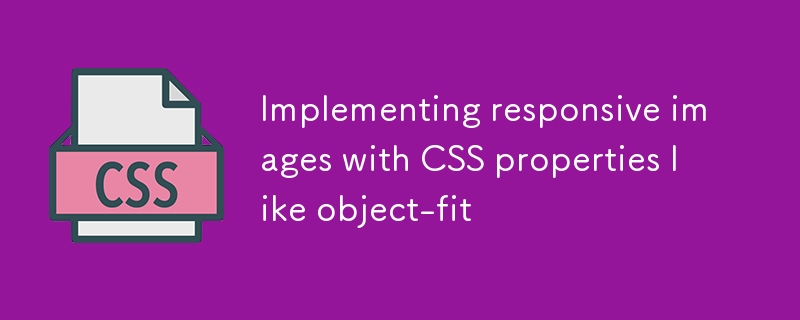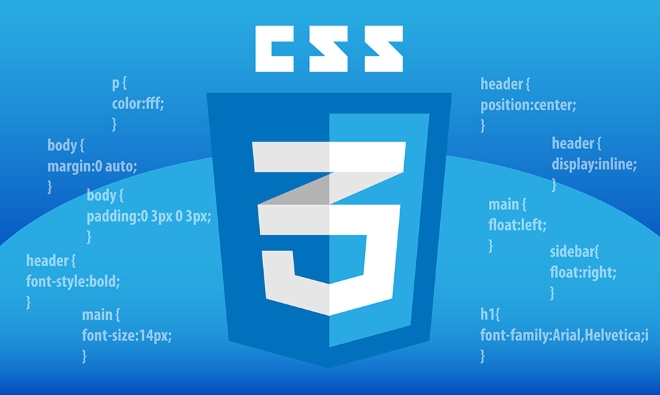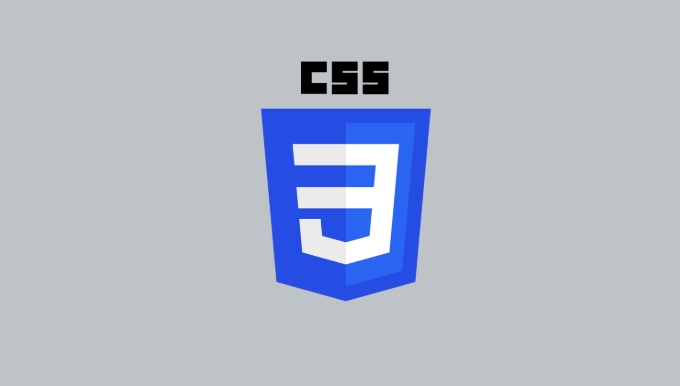Implementing responsive images with CSS properties like object-fit
Jul 13, 2025 am 01:40 AMTo make the images appear properly on different devices, object-fit, responsive layout and srcset technology are required. 1. object-fit controls the image scaling method. Common values include fill, contain, cover, scale-down, which is suitable for img and video elements; 2. Use @media query to realize layout adjustments under different screens, such as full width on the mobile phone and side-by-side display on the desktop; 3. Use srcset and sizes to let the browser select appropriate image resources according to the viewport to improve loading performance; 4. Pay attention to setting width and height to prevent layout jitter, avoiding misuse of object-fit in the background image, optimizing the quality of the original image and fully testing compatibility.

The proper display of pictures on different devices is an important part of modern web design. It is far from enough to rely on the img tag itself. Combining CSS attributes such as object-fit and responsive skills can truly make the picture "smart" adapt to various screens.

1. Understand the role and usage scenarios of object-fit
object-fit is a key property that controls how an image scales and aligns within its container. It has several commonly used values:

-
fill: stretching and filling the container (may deform) -
contain: Keep scaled to ensure the entire image is visible -
cover: Keep proportional cropping to ensure the container is filled -
scale-down: Take the smaller scale innoneandcontain
For example, if you are making a card component, the pictures inside are highly unified but the sources are different, using object-fit: cover can ensure that the visual consistency will not occur without black edges or deformation.
It should be noted that object-fit is only valid for img elements and video elements, but is not valid for background images. If you are using background-image , use background-size to achieve similar results.

2. Implement responsive image layout in combination with @media query
Images may require different display methods for different screen sizes. For example, on the mobile phone, you want the full width of the picture to be displayed; on the desktop, you may want to display several pictures side by side.
You can write this way:
img.responsive {
width: 100%;
height: auto;
}
@media (min-width: 768px) {
.responsive-card img {
width: 50%;
height: auto;
}
}In the example above, the image is full width by default, but when the screen width exceeds 768px, it becomes two columns side by side. This practice is very common and is especially suitable for article pages in content management systems.
Also, don't forget to set max-width: 100% to prevent image overflow from containers, which is one of the basic operations of responsive design.
3. Use srcset and sizes to let the browser choose the appropriate image resource
In addition to CSS, HTML can also be optimized. The <img src="/static/imghw/default1.png" data-src="image-small.jpg" class="lazy" alt="Implementing responsive images with CSS properties like object-fit" > tag supports srcset and sizes attributes, allowing you to provide multiple pictures with different resolutions and tell the browser to select the most appropriate resource based on the current viewport size.
Example:
<img src="/static/imghw/default1.png" data-src="image-small.jpg" class="lazy" srcset="image-small.jpg 480w, image-medium.jpg 800w, image-large.jpg 1200w" sizes="(max-width: 600px) 100vw, 50vw" alt="Responsive image" >
This code means:
- When the screen is less than 600px, use the full screen width (100vw) to load the picture of the corresponding size;
- Otherwise, load with half width (50vw).
This can reduce unnecessary large image loading and improve performance, especially for mobile users.
4. Frequently Asked Questions and Precautions
- Forgot to set
heightorwidth: it can easily cause layout jitter (CLS) and affect the user experience. - Misuse
object-fiton the background image : Remember to usebackground-sizeon the background image. - Ignore image quality : Even if responsive technology is used, if the original image is too large and heavy, it will also affect the loading speed.
- Inadequate testing : Different browsers have slightly different support for
object-fit, especially for older IE versions, polyfill can be added if necessary.
Basically that's it. The rational use of object-fit , srcset and media queries can make images perform more naturally on various devices and improve page loading efficiency. Although the details are small, the combination is obvious.
The above is the detailed content of Implementing responsive images with CSS properties like object-fit. For more information, please follow other related articles on the PHP Chinese website!

Hot AI Tools

Undress AI Tool
Undress images for free

Undresser.AI Undress
AI-powered app for creating realistic nude photos

AI Clothes Remover
Online AI tool for removing clothes from photos.

Clothoff.io
AI clothes remover

Video Face Swap
Swap faces in any video effortlessly with our completely free AI face swap tool!

Hot Article

Hot Tools

Notepad++7.3.1
Easy-to-use and free code editor

SublimeText3 Chinese version
Chinese version, very easy to use

Zend Studio 13.0.1
Powerful PHP integrated development environment

Dreamweaver CS6
Visual web development tools

SublimeText3 Mac version
God-level code editing software (SublimeText3)
 CSS tutorial for creating loading spinners and animations
Jul 07, 2025 am 12:07 AM
CSS tutorial for creating loading spinners and animations
Jul 07, 2025 am 12:07 AM
There are three ways to create a CSS loading rotator: 1. Use the basic rotator of borders to achieve simple animation through HTML and CSS; 2. Use a custom rotator of multiple points to achieve the jump effect through different delay times; 3. Add a rotator in the button and switch classes through JavaScript to display the loading status. Each approach emphasizes the importance of design details such as color, size, accessibility and performance optimization to enhance the user experience.
 Addressing CSS Browser Compatibility issues and prefixes
Jul 07, 2025 am 01:44 AM
Addressing CSS Browser Compatibility issues and prefixes
Jul 07, 2025 am 01:44 AM
To deal with CSS browser compatibility and prefix issues, you need to understand the differences in browser support and use vendor prefixes reasonably. 1. Understand common problems such as Flexbox and Grid support, position:sticky invalid, and animation performance is different; 2. Check CanIuse confirmation feature support status; 3. Correctly use -webkit-, -moz-, -ms-, -o- and other manufacturer prefixes; 4. It is recommended to use Autoprefixer to automatically add prefixes; 5. Install PostCSS and configure browserslist to specify the target browser; 6. Automatically handle compatibility during construction; 7. Modernizr detection features can be used for old projects; 8. No need to pursue consistency of all browsers,
 What is the difference between display: inline, display: block, and display: inline-block?
Jul 11, 2025 am 03:25 AM
What is the difference between display: inline, display: block, and display: inline-block?
Jul 11, 2025 am 03:25 AM
Themaindifferencesbetweendisplay:inline,block,andinline-blockinHTML/CSSarelayoutbehavior,spaceusage,andstylingcontrol.1.Inlineelementsflowwithtext,don’tstartonnewlines,ignorewidth/height,andonlyapplyhorizontalpadding/margins—idealforinlinetextstyling
 Styling visited links differently with CSS
Jul 11, 2025 am 03:26 AM
Styling visited links differently with CSS
Jul 11, 2025 am 03:26 AM
Setting the style of links you have visited can improve the user experience, especially in content-intensive websites to help users navigate better. 1. Use CSS's: visited pseudo-class to define the style of the visited link, such as color changes; 2. Note that the browser only allows modification of some attributes due to privacy restrictions; 3. The color selection should be coordinated with the overall style to avoid abruptness; 4. The mobile terminal may not display this effect, and it is recommended to combine it with other visual prompts such as icon auxiliary logos.
 Creating custom shapes with css clip-path
Jul 09, 2025 am 01:29 AM
Creating custom shapes with css clip-path
Jul 09, 2025 am 01:29 AM
Use the clip-path attribute of CSS to crop elements into custom shapes, such as triangles, circular notches, polygons, etc., without relying on pictures or SVGs. Its advantages include: 1. Supports a variety of basic shapes such as circle, ellipse, polygon, etc.; 2. Responsive adjustment and adaptable to mobile terminals; 3. Easy to animation, and can be combined with hover or JavaScript to achieve dynamic effects; 4. It does not affect the layout flow, and only crops the display area. Common usages are such as circular clip-path:circle (50pxatcenter) and triangle clip-path:polygon (50%0%, 100 0%, 0 0%). Notice
 How to create responsive images using CSS?
Jul 15, 2025 am 01:10 AM
How to create responsive images using CSS?
Jul 15, 2025 am 01:10 AM
To create responsive images using CSS, it can be mainly achieved through the following methods: 1. Use max-width:100% and height:auto to allow the image to adapt to the container width while maintaining the proportion; 2. Use HTML's srcset and sizes attributes to intelligently load the image sources adapted to different screens; 3. Use object-fit and object-position to control image cropping and focus display. Together, these methods ensure that the images are presented clearly and beautifully on different devices.
 Demystifying CSS Units: px, em, rem, vw, vh comparisons
Jul 08, 2025 am 02:16 AM
Demystifying CSS Units: px, em, rem, vw, vh comparisons
Jul 08, 2025 am 02:16 AM
The choice of CSS units depends on design requirements and responsive requirements. 1.px is used for fixed size, suitable for precise control but lack of elasticity; 2.em is a relative unit, which is easily caused by the influence of the parent element, while rem is more stable based on the root element and is suitable for global scaling; 3.vw/vh is based on the viewport size, suitable for responsive design, but attention should be paid to the performance under extreme screens; 4. When choosing, it should be determined based on whether responsive adjustments, element hierarchy relationships and viewport dependence. Reasonable use can improve layout flexibility and maintenance.
 What are common CSS browser inconsistencies?
Jul 26, 2025 am 07:04 AM
What are common CSS browser inconsistencies?
Jul 26, 2025 am 07:04 AM
Different browsers have differences in CSS parsing, resulting in inconsistent display effects, mainly including the default style difference, box model calculation method, Flexbox and Grid layout support level, and inconsistent behavior of certain CSS attributes. 1. The default style processing is inconsistent. The solution is to use CSSReset or Normalize.css to unify the initial style; 2. The box model calculation method of the old version of IE is different. It is recommended to use box-sizing:border-box in a unified manner; 3. Flexbox and Grid perform differently in edge cases or in old versions. More tests and use Autoprefixer; 4. Some CSS attribute behaviors are inconsistent. CanIuse must be consulted and downgraded.






